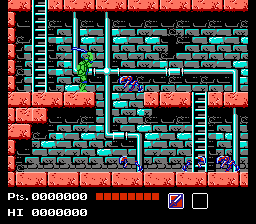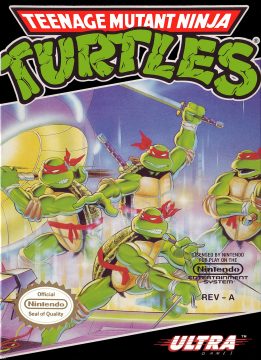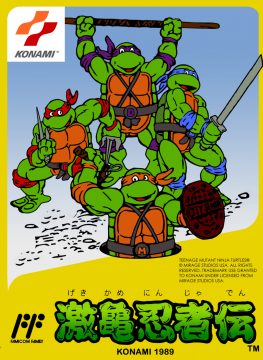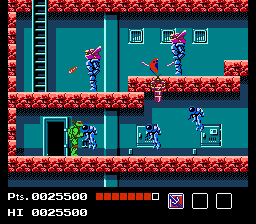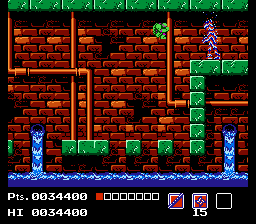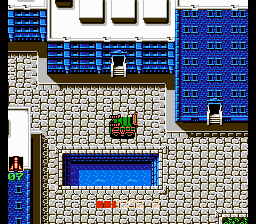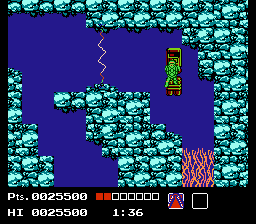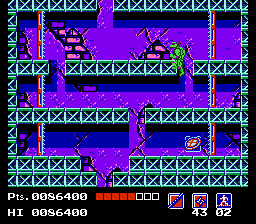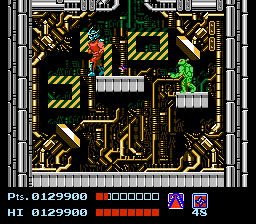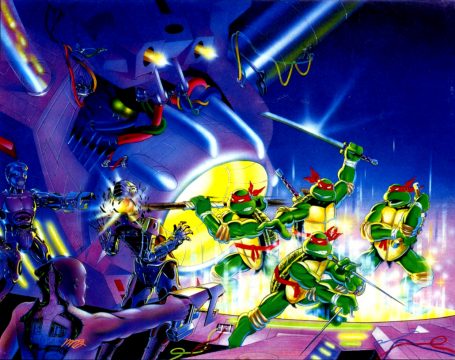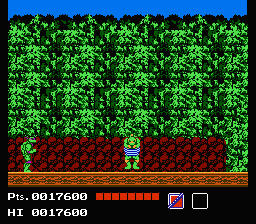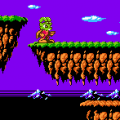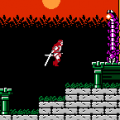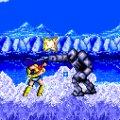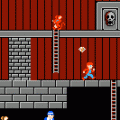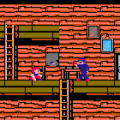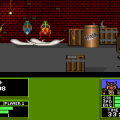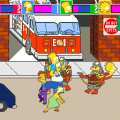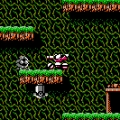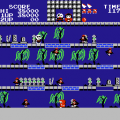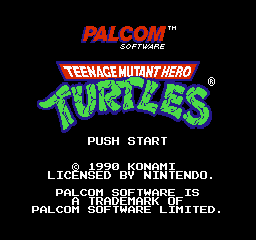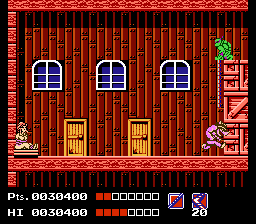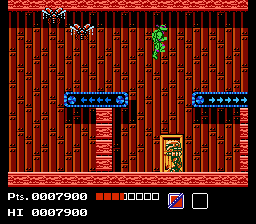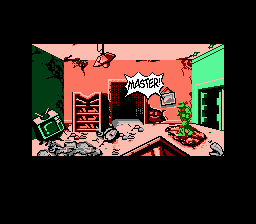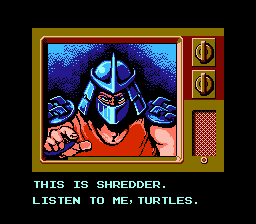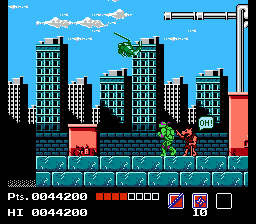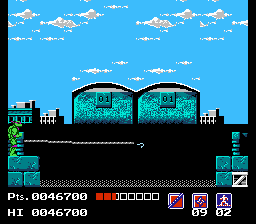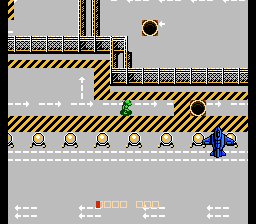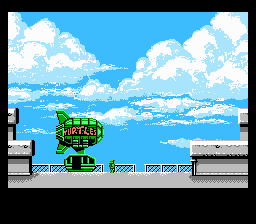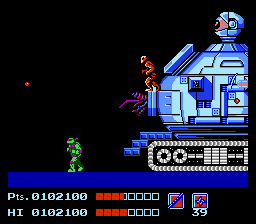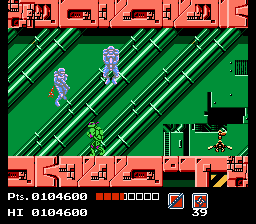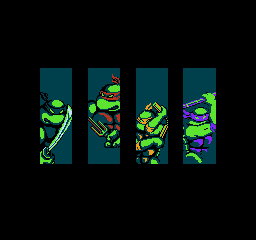- Teenage Mutant Ninja Turtles (NES)
- Teenage Mutant Ninja Turtles: The Arcade Game
- Teenage Mutant Ninja Turtles: World Tour
- Teenage Mutant Ninja Turtles: The Manhattan Missions
- Teenage Mutant Ninja Turtles III: The Manhattan Project
- Teenage Mutant Ninja Turtles: Turtles in Time
- Teenage Mutant Ninja Turtles: Hyperstone Heist
- Teenage Mutant Ninja Turtles: Fall of The Foot Clan
- Teenage Mutant Ninja Turtles II: Back From The Sewers
- Teenage Mutant Ninja Turtles III: Radical Rescue
- Teenage Mutant Ninja Turtles: Tournament Fighters (Genesis)
- Teenage Mutant Ninja Turtles: Tournament Fighters (SNES)
- Teenage Mutant Ninja Turtles: Tournament Fighters (NES)
- Teenage Mutant Ninja Turtles (Console – 2003)
- Teenage Mutant Ninja Turtles (GBA – 2003)
- Teenage Mutant Ninja Turtles 2: Battle Nexus (Consoles)
- Teenage Mutant Ninja Turtles 2: Battle Nexus (GBA)
- Teenage Mutant Ninja Turtles: Mutant Melee
- Teenage Mutant Ninja Turtles 3: Mutant Nightmare (Console)
- TMNT (2007) – Console
- TMNT (2007) – NDS and PSP
- Teenage Mutant Ninja Turtles 3: Mutant Nightmare (DS)
- TMNT (GBA)
- Teenage Mutant Ninja Turtles: Smash-Up
- Teenage Mutant Ninja Turtles: Arcade Attack
- Teenage Mutant Ninja Turtle (Plug and Play)
- Teenage Mutant Ninja Turtles Fast Forward: Ninja Training NYC / TMNT: Power of 4
- TMNT: Ninja Adventures – Mini-Game and Activity Centre
- Teenage Mutant Ninja Turtles: The Ninja Tribunal / The Shredder Reborn
- Teenage Mutant Ninja Turtles: Double Damage
The very first TMNT game came in 1989 on the NES, appropriately titled Teenage Mutant Ninja Turtles. Interestingly enough, Konami opted for a very different style of game to experiment with to set it apart from the action platformer genre the licensed games often fell under, and tried to make use of an essential part of the TMNT‘s allure, teamwork. All the turtles are at your disposal at any given time, though the game itself is strictly for one player only. As a work around to avoid Nintendo’s strict policy of the number of released titles per company over a fiscal year, the game was released under Konami’s Ultra Games banner. In Europe, the game used the UK enforced Hero Turtles banner and was released by Palcom, another of Konami’s subsidiaries.
Its Japanese release is probably the most interesting out of the many releases this single game saw. Released as Gekikame Ninja Den (“Legend of The Powerful Ninja Turtles”) prior to all other eventual releases around the world, Gekikame was actually the very first piece of TMNT related content to reach Japan. For many of the young Japanese audience, Gekikame would be their proper introduction to the Ninja Turtles franchise, albeit its story is not exactly the same one which the Western audience were familiar with. The overall plot remains more or less identical, apart from a very significant difference, that being April ‘O Neil. Channel 6’s most eager reporter is now Splinter’s daughter. Within the manual and in game, this fact is made clear in story and dialogue, though it is never further explained beyond just being an overlying detail. Subsequent games and TMNT merchandise in Japan changed April back to being a friend of the Turtles, not family. Gekikame can be considered itself another unique universe in the TMNT franchise, though one that did not materialize much further.
The story bases itself very loosely on the episode “Shredder & Splintered”, where the TMNT are after a retromutagen gun to turn Splinter human, though this game tells a more original self contained story to introduce the setting and characters within the universe. April O’ Neil has been kidnapped by Shredder’s bumbling henchmen duo Rocksteady and Bebop, and the four teenage turtles set out to rescue her. Leaving Splinter behind in their sewer hideout, the foursome maneuvers their way through the Foot Clan’s hideout in New York, and rescue’s April with relative ease. Before they can say “Cowabunga”, however, things take a turn for the worse when they discover that April was only a diversion, and in their absence the Foot struck and kidnapped Master Splinter. To make matters even worse, Shredder informs them that he has also placed bombs all over the Hudson River, and will blow up the dam, effectively flooding the city. The Ninja Turtles must now work together to save New York, rescue Master Splinter, and infiltrate the Technodrome to stop Shredder and the Foot Clan once and for all. Only then can they use the Life Transformer Gun to return Splinter into his human self.
Gameplay wise, Teenage Mutant Ninja Turtles mixes several styles, though the majority of the game is a sidescrolling action game. Once the game starts, the player takes control of Leonardo on an overworld location, free to walk around and explore a small area. Here, there are different locations that can be entered in a non linear form, letting players choose what to explore and also in some cases choose a route of their choice. Once a location is entered the game changes to the main play mode, sidescrolling action. This blend strongly resembles that of Zelda II: Adventures of Link, with similar small sprites and semi-linearity, though Ninja Turtles expands a bit on the overworld part by adding enemies that are engaged on the overworld rather than switching views upon contact and vehicles. It’s also heavily reminiscent of Konami’s Famicom title Getsu Fuuma Den – it also has an overworld, Leonardo’s sword attacks are very similar, and it shares many of the same sound effects.There is also an underwater based section to the game when dealing with the bombs along the dam, which is one of the few times the Ninja Turtles are shown using their natural marine instincts to use, as they are not often depicted in the comics or cartoons in water.
There are six sections to the game, all connected to each other by cutscenes. Fifth Avenue, Hudson River, Wall Street, JFK Airport, South Bronx and finally the Technodrome are all interactive and exploreable, though before you go and christen Teenage Mutant Ninja Turtles as the true father of Grand Theft Auto, the fact that these areas are not too accurate, nor too exciting. While it is definitely possible to board the Party Wagon, run over pedestrian Foot Soldiers and do drive by shootings, the locations are far from anything resembling New York architecture and landmarks. The Big Apple seems to have a particular Japanese feel to it with buildings often looking more like they belong in Osaka than New York City with distinct roof designs and structuring. JFK Airport makes Bagram Airbase look like Parc Asterix in comparison, being an absolute war zone with bombings, mines and barricades. In fact the only location that could remotely be argued to resemble its inspiration is the Hudson River, because the water is blue.
Throughout these levels, certain requirements are needed to be met to carry on to the next section of the game. The shellshockers’s mission changes per section, going from rescue missions, bomb disarming and infiltration. A map can be brought up at all times on the pause menu, where one can at any time change between the four brothers, and get some helpful advice from April or Splinter depending on the stage. The map comes in very handy as it shows the specific locations of various items that are required to venture on, however getting to these locations presents various challenges. Some stages requires simple exploration to find the right location to face a boss or the likes, while other stages requires more intricate maze navigation to find items such as missiles or magic scrolls to open up barricades along the overworld. This will take the turtles through sewers, rooftops, warehouses and underground caves. The one part that deviates from the formula set by the game, is the polluted waters of the Hudson River.
Every turtle has their own tactical advantage, though strictly offensively. Leonardo uses his katana to deliver a swift slice with good reach, Donatello has a much longer weapon range with exceptional strength though at a reduced speed, Raphael has a very quick and longer lasting spin of his sai while Michaelangelo… well he has no advantage. His nunchuks are the equivalent of swinging connected hot dogs around with terrible range and strength. Mikey would later bring this hot dog comparison into actual practice, as he used hot dogs as his weapon in the opening scenes of the live action blockbuster Teenage Mutant Ninja Turtles 2: Secret of The Ooze.
Offense aside, the four shelled reptiles share abilities between them. At the push of the A button in the sidescrolling sections, the TMNT will perform a high jump similar to that of Konami’s Contra, performing endless somersaults at impressive heights. Their arsenal can be further expanded by picking up various items such as shurikens, boomerangs and magic scrolls. These are activated easily by pushing the Select button and work well to take out foes far away or at a disadvantaging position. Items for other use is also scattered around, such as ropes to cross over rooftops and missiles for the Party Wagon, along with the standard refill items, which is in this case Pizza slices, or invisibility items in the form of a turtle head icon. During the Hudson River part, the A button must be tapped rapidly to ascend underwater, maneuvering carefully through radioactive seaweed and electric currents since there are no need for any strikes to be made.
More so than being known for its place in TMNT history or for its attractive features, Teenage Mutant Ninja Turtles is today most famously known for its brutal, sometimes illogical difficulty, one which has earned it a reputation of being the hardest NES game in existence. While that moniker is not really accurate, it certainly is an extreme experience to say the least, and few have ever managed to get through all the way to the end. There are many different reasons that makes this game so frustratingly hard. Its random enemy placement is one. Each enemy has a pattern to them, and these patterns can be mastered and broken down, but it is the regenerating factor that makes them so unpredictable. As soon as you leave the screen and backtrack, the game will generate a random number of enemies placed in different places, mostly at the severe disadvantage of the player, being right in front of or blazing across the screen at speeds that startle and surprise. Even worse, the turtles takes one out of the Castlevania playbook and bounce back when hit, which can lead several enemies being regenerated to worsen the situation. This isn’t just one enemy either, it can be up to five or six at any given time. The game is also cheaper than a prison when it comes to food supply, and the hunt for the pizza refills will often completely sidetrack you, as well as ultimately kill you since these pizzas are usually stored in areas swarming with bad guys. Each turtle has their own individual lifebar, and as such some strategy comes in when choosing and balancing through the beaked foursome’s life supply and area advantage. If a turtle is defeated, he is held captive by the Foot Clan, but can be retrieved by being saved by the remaining Turtles. Like the pizzas, finding the captive turtle requires some sidetracking and searching through enemy infested areas.
Enemies can be incredibly cheap outside of their respawning element as well. Nearly every enemy has a projectile as well as a close range attack, and they require several hits to be taken out. The air based antagonists often come at speeds and placements which feel unfair, especially due to the limited ability and range of the upwards stabs. Bosses are actually the only real pushovers throughout the majority of the game, having very specific and easily identified patterns and the static boss area screen also allows for a better overview of the battle itself. The boss difficulty takes a nasty spike with the Technodrome and Shredder later on, which again borders on being nearly impossible. For the most part, the bosses are the only ones that are directly inspired by the cartoon series, being Rocksteady, Bebop, Giant Mousers, Technodrome and Shredder. The most interesting boss is at Wall Street while rescuing Splinter. On this stage you face a evil twin turtle with a pale skin tone, only to reveal that it’s actually a robot in disguise. This can be seen as an inspiration for two characters to come in the TMNT universe. The evil twin turtle was later explored with the popular character of Slash, who appeared two years later in the cartoon and Adventures comic, and the mechanical turtle idea was later revisited with Mechaturtle.
The level design remains the most frustrating aspect to the entire game however. Generally the layout is passable and easily figured out, but some gaps and areas do not go well with the controls. The Ninja Turtles’s jump is somewhat uncontrollable due to extremely floaty physics, and precision is thrown out the window even though it is essential. Even the slightest tap of the jump button sends the turtle into moon like floating with any direction pressed sending him flying that direction. Small gaps near the roof will result in the turtle crashing in the roof and falling into the gap. This problem is especially damaging to the Wall Street part of the game, as the TMNT must navigate through the sewers they are so familiar with, but falling into the sewer water will transport you back to the entrance of that section. With these narrow jumps, it certainly doesn’t help that there is often more than one enemy on the edge on the platform you are trying to reach, leading to hits which bounces one backwards and into the waters. The underground leading up to the Technodrome is a maze system which requires the turtle brothers to search for the cycloped golfball through caves swarming with mutants which require a ton effort to kill, and can do such substantial amounts of damage with just one hit. Ironically, the stage that is most often cited as the hardest, the Hudson River, is the easiest out of all the stages due to it being a very simple path which is easily learned and finished in a minute or so. Its reputation is probably due to it being the more visually and audibly memorable stage which comes first to mind when thinking back.
But as aggravating as the difficulty can be, the game looks and sounds absolutely gorgeous. The sprites are detailed and lavish, with great depth and detail on the various characters as well as on the tiles and backgrounds. Scenery always has a distinct look to it, making all the areas over the course of the game feel diverse and varied enough to make each stage memorable in its own way visually. The overworld lacks a certain flair to it though, often looking empty and dull, but limited time is spent on the streets so fortunately it does not drag on with the boring visuals. The music is believed to have been composed by Kozo Nakamura, a composer that would remain with the series throughout most of the Konami produced titles. The reason why this is not certain is that there is no official credits in the game, and Konami of America does not have the documents with the specific staff members listed. Due to copyright reasons, none of the music is actually based on the very famous TMNT 1987 tunes (the music copyright issue is one that still prevails to this day due to a complicated web of legalities) but this works to its favor, crafting an all original pop jazz fusion soundtrack with some hard rock thrown in during the boss battles. The soundtrack still remains one of the most well regarded NES soundtracks of all time.
At times this game comes under attack for not reflecting the TMNT 1987 cartoon all that well, especially by Youtube videographers who inexplicably do commentary with little to no research whatsoever. A quick timeline inspection and director of the first live action film, Steve Barron and details from Bey Logan and the Golden Harvest production of TMNT the movie clears up some questions and rumors surrounding the game. Negotiations for licensing rights began in 1986 with various developers on what was then, an underground comic sensation that had an upcoming toyline and TV miniseries that was not established in mainstream circles yet. When Konami was set to the task of making the game, their design documents and resources from Mirage and Surge licensing were based on the original comic and a brief overview of the TV show that debuted in late December 1987. This resulted in the game becoming a hybrid of the original comic and 1987 cartoon series, a bridging of the two very different iterations of TMNT. Barron explains further that when the movie initially began funding and planning, the details on the story was very brief and only had certain scenes, the kidnapping of Splinter and the burning of the antique store. This is why some scenes are shared between the game and the movie despite them being so far apart in release date.
This fact probably helped the game become the million dollar seller more than what it’s given credit for. The cartoonization of the very gritty reptilian mutants had left the original fanbase disgruntled, to put it mildly, and the 1987 show was as close to a bizarro world as it could be – a bright art style and slapstic humor, essentially a half hour toy commercial, though with a certain amount of heart. Teenage Mutant Ninja Turtles manages to blend elements just so both fanbases can find enjoyment within, and also creates a style unique to the game, for example blending the red clothed Shredder from the Mirage universe with the toony sidekicks Rocksteady and Bebop. A complaint that often arises from fans is the cast of enemies, which consists of weird aliens and an ensemble of unknowns. While it’s true the majority of the enemies are completely original, by the time the game was in actual development, the cartoon show simply didn’t feature a very large cast beyond the central figures. The more sci-fi inspired enemies featured does reflect the original comics which featured more science fiction elements due to Laird’s love for the genre. Further bridging was done with the cover art. Though probably more of an accidental move rather than planned marketing, the use of Mike Dooney’s art from the TMNT #4 reprint issue from 1987 drew in the comic book fans with a familiar image, though the red bands across the entire cast of turtles led to a common misperception that the cover was subject to a print error. For those who are only familiar with either the cartoon show or the origin comics might have trouble seeing the true benefit of this game’s content and style.
Teenage Mutant Ninja Turtles is a rather enigmatic experience. An overtly hair-pulling game littered with unreasonable level design and blistering difficulty, yet with an undeniable charm and quality, creating a counter balance that gives the game a unique feel of being completely playable, but ultimately near undefeatable. It is probably the game most NES owners had, which they have never been able to beat. The timing of its release couldn’t have been more apt, as the TMNT phenomenon had just exploded into mainstream, and it went on to sell an astonishing four million copies worldwide. At the time of its release, Teenage Mutant Ninja Turtles was met with positive response, even winning Game of the Year from Nintendo Power and residing on their top 10 list for a record amount of time. In Japan the game saw a less enthusiastic release, selling poorly due to the relative obscurity of the source material. Now that time has passed, both critical and public perception has changed significantly, mostly due to Youtube videos and comedy review sites. While it suffers from some very apparent design issues, it’s still a fun experience and visually pleasing game that was adequate when released. When put besides the entire series of TMNT games to come however, it isn’t the strongest title by a long shot.
After its release, Teenage Mutant Ninja Turtles appeared on the Play Choice 10 arcade cabinet from Nintendo. It also gained another historic mark onto its name, being the first licensed game to appear on the Wii Virtual Console. Due to the license being owned by someone else, the game was marked at 100 points extra compared to the normal 500 price point for NES games on the service as a way to make up for the extraordinary licensing fee. The game proved popular enough in Europe to be bundled with the Nintendo Entertainment System in a special offer.
NES Times Hoax
in 2003, some confusion arose due to the appearance of some screenshots that were believed to be from either a prototype cart or an undiscovered secret which had not been unearthed until then. The pictures showed a forested area with a tied up turtle able to be freed and restored to the team. This turned out to be a hoax created by Andrew B. At the time, Andrew was operating the fansite NES Times, and it was here that the TMNT hoax was displayed along with “directions” on how to enter the area. According the the hoax, if players choose to kill all Foot Soldiers during the overhead parts of the dam and refrained from jumping in the water, they could continue walking towards the right part of the screen and free a brother in trouble if they were indeed captured. NES Times has since then been discontinued.
